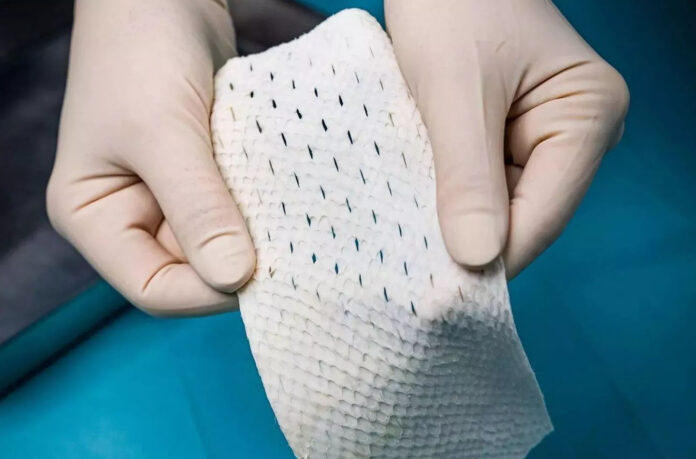From the battlefield to the operating room, new technology is offering hope to patients.
Kerecis received authorization from the FDA to market Kerecis Omega3 SurgiBind™ in October 2021. Before the product was approved for civilian use, the technology had been used in the military to help heal wounded soldiers on the battlefield. Crespo Soto was involved in a pilot study in 2019 at Atrium Health Pineville to evaluate the new technology. Results of the study found the product decreased the need for patients to be admitted or undergo a skin graft operation, decreased the surface area of the wound, reduced pain and shortened healing and recovery time.
This technology, which is the first FDA-certified fish-skin implantable, uses the skin of North Atlantic cod. When grafted onto damaged human tissue, the fish skin recruits the body’s own cells and ultimately is converted into living tissue. The product is intended for implantation to reinforce soft tissue where weakness exists, such as in patients requiring soft tissue repair or reinforcement in plastic or reconstructive surgery.
Crespo Soto said this innovative technology creates an environment for the patient’s own tissue to regenerate. “The material resembles human skin – but it’s robust, pliable and tear-resistant. It can be easily cut or meshed for application and only requires brief hydration with saline before use,” said Crespo Soto.
The fish-skin device is Kerecis’s first implantable medical device created for the surgical market to help physicians better manage the risk of complications and improve results. The company has several fish skin products on the market that all are indicated for topical use. SurgiBind is the company’s first implantable product.
“We have seen very good clinical outcomes at Atrium Health’s Sanger Heart & Vascular Institute,” said Fertram Sigurjonsson, founder and CEO of Kerecis. “The partnership that we have with Sanger Heart & Vascular Institute is based on the principles of innovation and surgical excellence, both of which are very important for us. With the designation of excellence, we want to award facilities that put compassion in the spotlight by aiming for improved surgical outcomes for all patients.”
While the product can be used in a variety of ways, it is notably used to prevent amputation where the wound is located. Soto said the technique has had a tremendous impact on patients who are involved with Sanger’s innovative limb salvage program, which was launched in 2012 to reduce unnecessary or preventable amputations and save patients’ limbs.
Crespo Soto said since the study began in 2019, the fish-skin technology has been used in 200-300 cases a year where it has been used to treat patients and help drive positive outcomes.
“The team at Atrium Health’s Sanger Heart & Vascular Institute has been instrumental in making a great effort to take care of our patients,” said Crespo Soto. “I think this helps us expedite the care our patients need and helps us give our patients a better quality of life by allowing wounds to heal faster than they would with standard care.”







